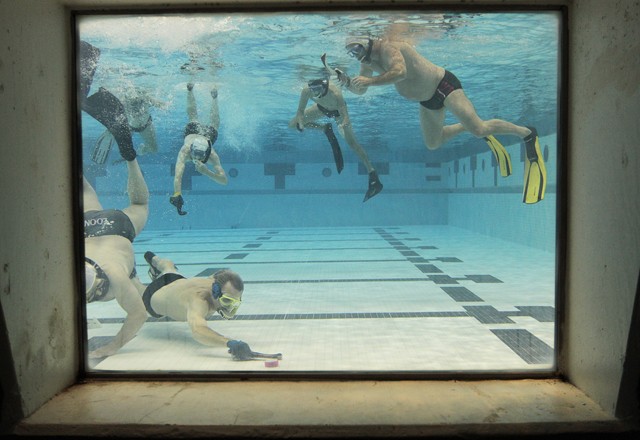The University of Minnesota may be known nationally for its ice hockey program, but a small group of faculty and community members are making a splash with a slightly different take on the game âÄî one thatâÄôs played underwater.
âÄúUnderwater what?âÄù
ThatâÄôs the reaction most people have when they first hear about underwater hockey, said Ben Erickson, a University researcher whoâÄôs played four times on the national underwater hockey team, representing the United States in Europe, Australia and New Zealand.
To the uninitiated, the sport âÄî which combines elements of ice hockey and water polo âÄî often draws skeptical comparisons to âÄúunderwater basket weaving,âÄù he said.
But for Erickson and some 1,200 other players nationwide, the game can be serious business.
âÄúItâÄôs taken me half way around the world and back,âÄù Erickson said.
In the pool for underwater hockey thereâÄôs a puck, sticks, goals and six players to a side, but the similarities to ice hockey end there.
Under the water, players trade ice hockeyâÄôs protective pads for flippers, snorkels and tight swimwear, often Speedo-style trunks for men and one-piece suits for women.
Snorkels and goggles allow players to keep their eyes on the puck and find the play even when they surface for air, which they do about every 10 seconds, before diving as deep as nine feet for a crack at the puck.
Despite the constant ascents to come up for air, the action rarely stops mid-play.
âÄúAs you get more and more experienced, you get better at predicting when the puck is going to come to you, so you can try to be in the right spot with air,âÄù said Ben Holtzman, who played underwater hockey at the University of Illinois before getting his masterâÄôs degree in the spring.
The sport attracts athletes primarily from water sports such as swimming and diving, but EricksonâÄôs Minnesota Loons Underwater Hockey club sees male and female athletes as young as 17 and older than 50, some who have had no real swimming experience elsewhere.
While the Underwater Society of America states the game prohibits âÄúbrute force,âÄù itâÄôs considered a non-contact sport âÄúin the same way basketball is considered non-contact.âÄù
Underwater, bigger players arenâÄôt able to manhandle smaller ones the way they could on dry land, Holtzman said.
A University club
Erickson hopes to start a University club team that could square off against club teams at other Big Ten schools such as the University of Wisconsin and Michigan State University.
Gabbi Simon, secretary of the University of MichiganâÄôs underwater hockey club team, said that without a background in swimming, she followed two of her sisters into the sport.
Simon, an animal science sophomore, said she learned the game quickly and is now competing with the team against clubs from across the United States and Canada.
âÄúIf you stick with it and go to at least five practices, then youâÄôll really get the hang of it,âÄù Simon said. âÄúItâÄôs something you can catch on to really quickly.âÄù
Erickson has been playing the sport since the early âÄô80s, and heâÄôs spent time as a commercial diver and working in a dive shop, but he now works in fluid mechanics at the Saint Anthony Falls Laboratory.
âÄúI find it poetic every day,âÄù he said of his life spent around water.

Image by Joe Michaud-Scorza
The Minnesota Underwater Hockey Club scrimmages at the University Aquatic Center on Sunday.
Underwater hockey breaks ice at U
The game, which is a fusion between ice hockey and water polo, is played around the world.
by Ian Larson
Published November 4, 2010
0

